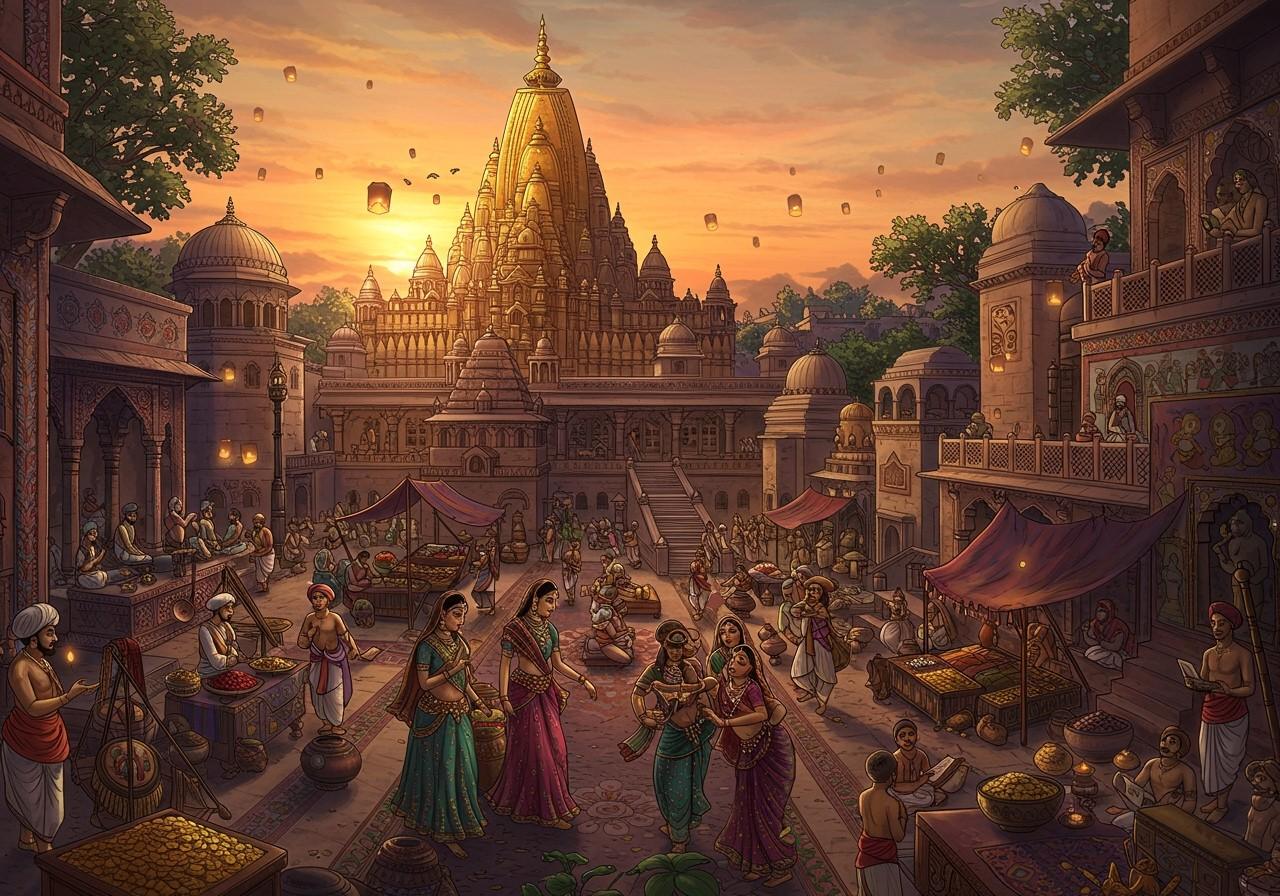
The Gupta Dynasty, often hailed as India’s Golden Age (320-550 CE), witnessed remarkable prosperity, cultural flourishing, and significant advancements. To understand life during this period, we must explore the intricacies of its society, culture, and economy.
Society in the Gupta Dynasty
Social Structure and Family
Gupta society adhered to the Varna system, comprising Brahmins (priests), Kshatriyas (warriors), Vaishyas (merchants and farmers), and Shudras (laborers). The joint family system was prevalent, with multiple generations residing together and sharing resources.
- Varna System: This hierarchical system defined social roles and responsibilities, contributing to social order.
- Joint Family: This structure provided stability and support within the community, emphasizing collective well-being.
Education, Religion, and Governance
Education was highly valued, with renowned universities like Nalanda and Takshashila attracting scholars from far and wide. Hinduism was the dominant religion, coexisting with Buddhism and Jainism. The king held central authority, supported by a network of local officials. This era saw the rise of prominent scholars like Kalidasa and Aryabhata, contributing immensely to literature, science, and mathematics.
- Education: Centers of learning like Nalanda and Takshashila fostered intellectual growth and knowledge dissemination.
- Religious Harmony: Although Hinduism was prominent, other faiths like Buddhism and Jainism thrived, contributing to a rich spiritual landscape.
Cultural Aspects of the Gupta Era
Art, Architecture, and Literature
The Gupta period witnessed a golden age of artistic expression. Intricate temples and stupas showcased architectural prowess. Paintings and sculptures depicted religious and secular themes, reflecting the era’s artistic sophistication. Literary masterpieces, like those by Kalidasa, enriched Sanskrit literature.
- Artistic Flourish: Various art forms, including sculpture, painting, and architecture, reached new heights of refinement and complexity.
- Literary Achievements: Poets and playwrights like Kalidasa produced timeless works that continue to be celebrated today.
Music, Dance, and Festivals
Music and dance were integral to daily life, with various instruments and dance forms enriching cultural celebrations. Festivals like Diwali and Holi were observed with great enthusiasm, fostering community bonding and religious observance. Gupta culture extended its influence through trade and diplomatic relations with neighboring regions.
- Cultural Celebrations: Music, dance, and festivals played a vital role in social life, expressing religious devotion and community spirit.
- Cultural Exchange: Interactions with neighboring regions facilitated the exchange of ideas and traditions, enriching the cultural landscape.
Economic Structure of the Gupta Empire
Agriculture and Trade
Agriculture formed the backbone of the Gupta economy, with crops like rice, wheat, and sugarcane being staples. Extensive trade networks connected the empire with Southeast Asia, the Middle East, and Europe. This trade brought prosperity and facilitated cultural exchange.
- Agricultural Prosperity: The cultivation of essential crops ensured food security and supported the growing population.
- Extensive Trade: Robust trade networks facilitated the exchange of goods and ideas, contributing to economic growth and cultural diffusion.
Guilds and Currency
Guilds played a crucial role in regulating trade and industry, ensuring quality and standards. A standardized currency system, using gold coins, facilitated trade and economic transactions. Merchants played a key role in accumulating wealth and promoting cultural exchange.
- Guilds and Commerce: These organizations played a vital role in maintaining quality control and promoting fair trade practices.
- Standardized Currency: The use of gold coins simplified transactions and promoted economic stability.
Daily Life in the Gupta Empire
Daily life in the Gupta Empire was characterized by a rigid social structure, economic prosperity, and cultural flourishing. People lived in bamboo or wooden houses with thatched roofs, often with only one room. Villages were noisy with narrow streets, bustling markets, and craftsmen practicing their arts. Religious practices, particularly Hinduism, influenced daily life, and clothing styles included dhotis, sarees, and turbans.
Traditional Ritual Items for Cultural Ceremonies at Poojn.in
The rich cultural traditions of the Gupta Dynasty continue to influence modern Indian ceremonies. At Poojn.in, we offer authentic items for these practices:
- Premium Topor Mukut Sets (₹1,999): Hand-crafted shola headpieces, perfect for Bengali weddings, reflecting Gupta-era grandeur.
- Pure Cotton Gamcha (₹60): Essential for various religious ceremonies, connecting modern practices with ancient traditions.
Poojn.in offers quality-certified, authentic products delivered across India with secure online payments. Visit www.poojn.in for traditional puja items.
FAQs on Gupta Dynasty Life
Dress and Jewellery
People wore simple yet elegant clothing. Men typically wore dhotis, while women favored sarees, often made of cotton or silk. Jewellery was intricate, crafted from gold, silver, and precious stones. Both men and women adorned themselves with necklaces, rings, bangles, and earrings.
Role of Women
Women held significant roles in the household and society. While their primary focus was family, they also participated in education, arts, and sometimes even politics.
Economy and Contributions to Arts and Culture
The Gupta economy thrived on agriculture and trade. The dynasty is renowned for its contributions to arts and culture, including literature, music, dance, and visual arts. Sanskrit literature and temple architecture flourished during this period.
Social Structure
Gupta society was structured according to the Varna system, influencing social roles and interactions. However, social mobility was possible through education and trade.
Conclusion
The Gupta Dynasty represents a pivotal period in Indian history. Its interwoven society, culture, and economy created a vibrant and prosperous era. The structured social system, emphasis on education and religion, and flourishing arts and culture left an enduring legacy. This golden age continues to inspire and inform, offering valuable insights into India’s rich past.
Note: Prices mentioned are current at the time of writing and may vary.


